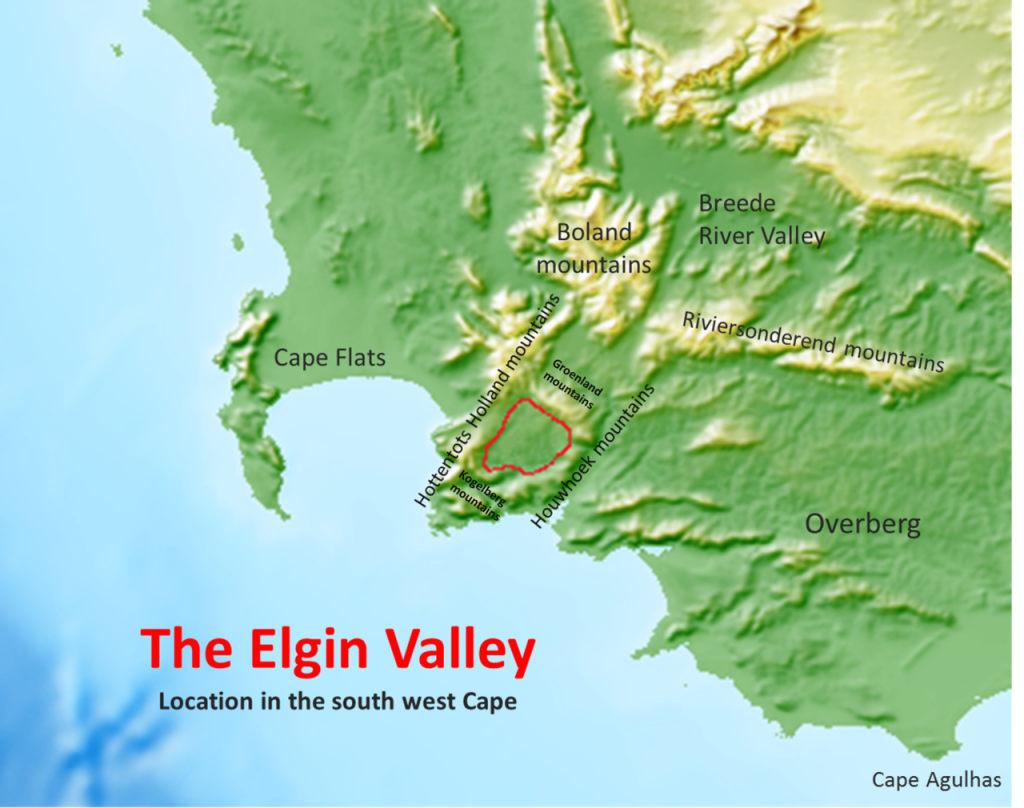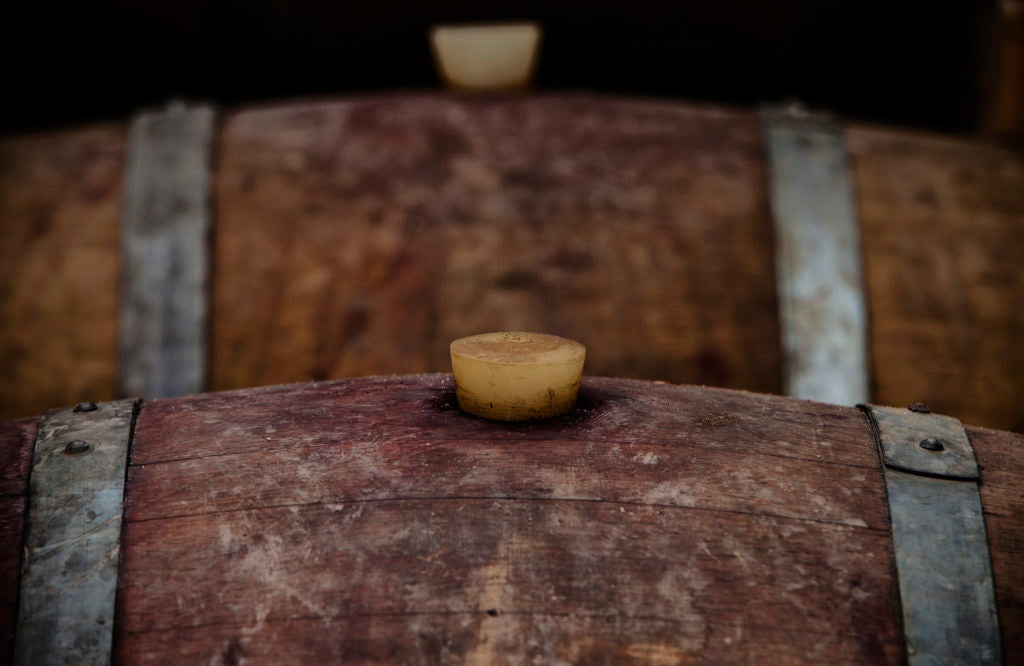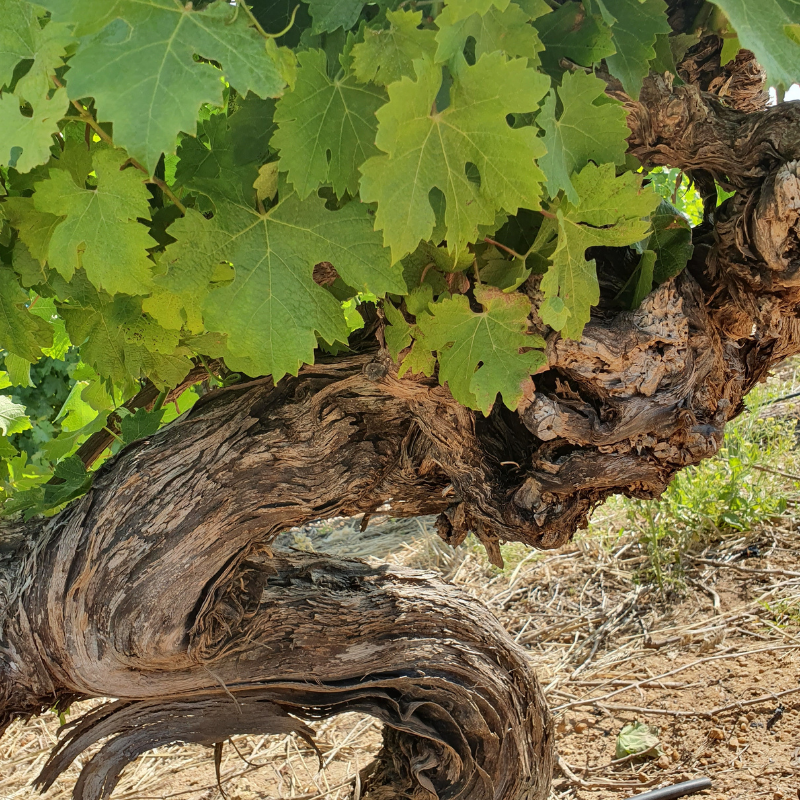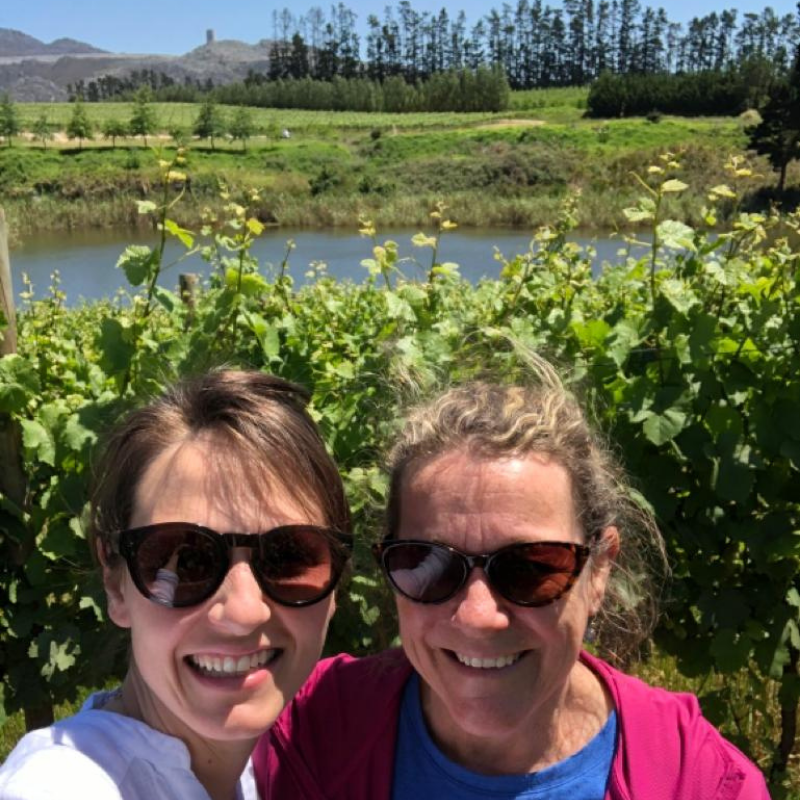
ElGIN VALLEY
ORIGIN OF “ELGIN” – In the late 1800s, a locally-born child named “Elgine Herold” was killed by snakebite near the Palmiet River. Her distraught father named the area of land “Elgin” in his daughter’s memory, with support from other locals.
Two main events caused this name eventually to be used for the entire valley. Firstly, when the earliest railway was built through the area, it was found that this plot of land was the most suitable for a railway station, and the station was consequently also named “Elgin”. For decades, this station provided the main connection between the people and produce of the valley, and the outside world. The name therefore became known around the world due to Elgin’s famous agricultural produce. Secondly, two young brothers had bought a small plot of land here named “Glen Elgin” in 1903, where they grew vegetables. The Molteno brothers were partially responsible for revolutionising the region’s deciduous farming industry and, in an unusual move in the 1950s, they ordered that their vast “Glen Elgin” farming enterprise was to be divided up and returned “…to Elgin’s farmworkers and inhabitants for their own use.”The name “Elgin” thereby gained a certain significance, as the name by which some of the region’s land first began to be shared with the majority. (https://en.wikipedia.org/wiki/Elgin,_Western_Cape)
GEOGRAPHY OF ELGIN VALLEY
Elgin is situated close to the southern Cape coast between Sir Lowry's Pass in the southeast (outside Somerset West) to Bot River (en route to Hermanus) and Villiersdorp to the northwest in the Overberg region. It is about 70km east of Cape Town, just beyond the Hottentots Holland mountain range and is centred around the village of Grabouw.
The Elgin Valley, like most of the Western Cape experiences a typical Mediterranean climate with warm, dry summers and cold, rainy winters. The Elgin Valley is elevated from 350m to 600m above sea level and is surrounded by mountains. It is the 4th highest altitude in South Africa and lies approximately 20 km away from the Atlantic Ocean with its cold Benguela current. The prevailing south easterly wind brings cool, maritime air into the Valley bowl and is trapped under an almost permanent cloud cover that keeps the average temperatures cooler than the rest of the wine growing region.
CLIMATE OF ELGIN VALLEY
The macroclimate of the Valley is made up of many varied microclimates that influence the flavour intensity of the vineyard sites selected.
Of the five Winkler index parameters (heat summation index or summation of temperature above 100Celsius over 7 months) the Elgin Valley falls within the Winkler I , II and III indexes, depending on where the site is situated in the Valley, which determines the best climate for growing specific wine grape varieties. This depends on the slope, aspect and sun exposure of a vineyard site within the Elgin Valley.
Winkler I (Cold): Sauvignon Blanc, Riesling, Chardonnay
Winkler II (Cool): Sauvignon Blanc, Pinot Noir, Merlot, Cabernet Franc
Winkler III( Medium): Semillon, Syrah
Generally, the Valley experiences average daytime temperatures of 150Celsius in July to 250Celsius in March at harvest and night-time average temperatures of 50Celsius in July which is excellent for winter vine dormancy to 150Celsius in March. These cold night-time temperatures are specifically important to preserve fresh, bright and aromatic profiles and good acidity of both white and red varieties.
Elgin receives about 950mm of rainfall per year and receives most of its rainfall during the winter months (May to September) since it is a Mediterranean climate.
Average rainfall values for Elgin are the lowest rainfall in January (22mm) and highest in June (160mm).
SOIL OF ELGIN VALLEY
On the coastal regions, ancient geological formations and extended periods of exposure to weathering, without extensive covering by younger material of glacial or alluvial deposits by earthquake or volcanic activity, means that vines are grown on some of the oldest materials and soils in the world.
The main soils in the Elgin Valley consist of ancient sandstone with coarse fragments of silica quartz and shales that are predominantly iron-rich. The soft, porous Bokkeveld shales are highly acidic as they have been well weathered and exist over water holding substrates which are ideal for available soil water uptake during the growing season. The substrate soil layers are red granite and white caoline clays.
There are at least 50 different soil combinations since the Valley was a riverbed millions of years ago.
These varying soil profiles create an excellent canvass for growing and producing wines of unique character and distinction.
Pinot Noir grown in Sandstone soils, tend to produce wines with lifted red berry fruit aromatics like cranberry, pomegranate and cherry with a light and ethereal yet generous structure and persistence on the finish.
Clay soils or Bokkeveld Shales found in both Elgin and Hemel-en-Aarde valleys , produce wines with depth, weight and power. Aromatics tend toward savoury, earthy and truffle-like. The blocky structure and suede tannins are derived from the high iron ferrous content in the soil.
The combination of the two soils reflects a wine of complexity, character and harmony.
Laterite soils also occur in small parcels in Elgin and Swartland resembling coffee granules texture, hence, the name Koffie -klip in Afrikaans.
Laterites are derived from a wide variety of rocks weathering under strongly oxidizing and leaching conditions.
Laterite is both a soil and a rock type rich in iron and aluminium and is commonly considered to have formed in hot and wet tropical areas. Nearly all laterites are of rusty-red coloration, because of high iron oxide content. Wikipedia
VINEYARD SELECTION
After many years of scouring the Western Cape vineyard sites, Cape south Coast was the region that was of most interest. The decision in 2007 to work with the majority of Elgin fruit was taken where strong grower ties were forged.
Close collaboration with the growers in the vineyard with regards to pruning, canopy management, size of crop, optimal vine and cluster ripeness, harvest dates and wine production are conducted.
Other sites for Pinot Noir outside of Elgin include the Hemel-en-Aarde Ridge.
Swartland for the newly added Grenache which prefers hot Mediterranean climates, and a small parcel of Chenin Blanc, Merlot and Cabernet Franc from Stellenbosch sources.
VINE GROWING
The varieties best suited to cool climate like Sauvignon Blanc, Riesling and Pinot Noir are usually grown on east facing slopes with morning sunlight while the more robust reds like Merlot and Cabernet Franc require warm afternoon west facing slopes to ripen completely.
Vines grown in cool climate Elgin and Hemel-en-Aarde are generally harvested 3 weeks to a month after Stellenbosch and Paarl. The benefit of growing vines in cool climate conditions is that the hang time for clusters is extended for more complete ripening of fruit flavours, tannins and there is a noticeable increase in intensity without compromising the delicate, aromatic fruit profiles. An added benefit is that alcohol levels are kept in check too. The most important consideration for growing vines in cool climates, is the natural maintenance of good, natural acid levels in grapes which ultimately determines freshness, brightness, purity, vibrancy, longevity, balance and overall harmony in the wine. In warmer grape growing regions, this aspect for cool climate varieties is often compromised.
Vine canopies and crop loads are monitored regularly during the growing season to enhance flavour production and ripen the tannin profile optimally so that the resultant wines are balanced. Leaf plucking timed correctly for cluster exposure to "burn" off green pyrazines (green compounds) without burning the delicate fruit flavours is applied under well researched weather forecasts just prior to harvesting.
All grapes from vines purchased, both red and white varieties are vertically shoot positioned on five wired fence-styled trellises. This allows for good vineyard husbandry and easy access for harvesting the clusters.
There is stringent control on herbicide, pesticide and fungicide applications that is strictly auditored so that all vineyards that are currently used for our wines are sustainably accredited.
Irrigation, mostly under drip systems at each vine, is applied according to soil moisture requirement and tested during the growing season on a regular basis by means of tensiometres and pressure bomb apparatus to determine accurately the quantity of water to be scheduled per vine. Grenache, however, is no irrigated at all.
Harvest decisions are based on vine and cluster ripeness that is monitored very carefully by both tasting the berries and laboratory analysis to ascertain the parameters required for the style of wine to be made.
Clusters are hand harvested into 17kg baskets and are mostly sorted in the vineyard so that matter other than grapes are brought to the cellar.
Elgin: Season 2, Episode 4
by Wines of South Africa Podcast
OUR PHILOSOPHY

VINE GROWING
The varieties best suited to cool climate like Sauvignon Blanc, Chardonnay, Riesling and Pinot Noir are usually grown on east facing slopes with morning sunlight while the more robust reds like Merlot and Syrah require warm afternoon west facing slopes to ripen completely.
Vines grown in cool climate Elgin are generally harvested 3 weeks to a month after Stellenbosch and Paarl.
READ MORE
The benefit of growing vines in cool climate conditions is that the hang time for clusters is extended for more complete ripening of fruit flavours, tannins and there is a noticeable increase in intensity without compromising the delicate, aromatic fruit profiles. An added benefit is that alcohol levels are kept in check too. The most important consideration for growing vines in cool climate Elgin, is the natural maintenance of good, natural acid levels in grapes which ultimately determines freshness, brightness, purity, longevity, balance and overall harmony in the wine. In warmer grape growing regions, this aspect is often compromised. Vine canopies and crop loads are monitored regularly during the growing season in order to enhance flavour production and ripen the tannin profile optimally so that the resultant wines are balanced. Leaf plucking timed correctly for cluster exposure to “burn” off green pyrazines (green compounds) without burning the delicate fruit flavours is applied under well researched weather forecasts just prior to harvesting. All grapes from vines purchased, both red and white varieties are vertically shoot positioned on five wired fence-styled trellises. This allows for good vineyard husbandry and easy access for harvesting the clusters. There is stringent control on herbicide, pesticide and fungicide applications that is strictly auditored so that all vineyards that are currently used for our wines are sustainably accredited. Irrigation, mostly under drip systems at each vine, is applied according to soil moisture requirement and tested during the growing season on a regular basis by means of tensiometres and pressure bomb apparatus to determine accurately the quantity of water to be scheduled per vine. Harvest decisions are based on vine and cluster ripeness that is monitored very carefully by both tasting the berries and laboratory analysis to ascertain the parameters required for the style of wine to be made. Clusters are hand harvested into 17kg baskets and are mostly sorted in the vineyard so that matter other than grapes are brought to the cellar.

WINE MAKING
After spending many years focusing on Pinot from every site in the Western Cape, from Stellenbosch to the Outeniqua Mountains, it was clear that the Elgin Valley was the place that best suited the style of wines that we liked to create. Given the threat of global warming on our craft, it seems more and more likely that cool climates are necessary to produce wines of finesse, purity and vibrancy. Most of the attention is on ‘farming for flavour’ where vineyard husbandry is the focus.
READ MORE
This means less intervention in the winery, where more natural wines with minimal applications of fermentation aids, finings and must adaptations are required. The naturally higher levels of acidity and lower pH means cleaner wines with expressive red fruit and mineral texture. Lower alcohols and elevated levels of aromatic compounds are also evident. All the parcels of grapes that are delivered to the cellar are kept apart and treated as single lots from crush to blending. In this way, the integrity of site characteristics and flavour profiles are continued. A small stainless steel basket press and predominantly small French oak casks for red wines and handcrafted stonecast clay amphorae for white wines maximise the variety’s classic attributes.
SAUVIGNON BLANC
Notably the most consumed white variety globally. In France, dry wines are produced in Sancerre, Pouilly-Fumé, Loire, Graves (usually blended with Semillon) and the legendary sweet Botrytis (Noble rot) wines from Sauternes in Bordeaux. New Zealand leads the New World pack as the intense aromatic profile in their wines is very obvious. In South Africa, plantings are found throughout the Western Cape where the cool climate aspects in Elgin produce wines of distinction and have gained International prominence and are often considered both New World and Old World in character. Sauvignon Blanc’s highly aromatic and perfumed notes may have herbaceous “green” notes like fresh cut grass, capsicum, nettles, pink grapefruit and limes. The more riper, tropical notes include passion fruit, gooseberry, cat pee and blackcurrant. Compounds that are responsible for these aromatics are called methoxypyrazines (green notes) and mercaptopanthanones (tropical notes) that influence the outcome of the wine depending on the ripeness at harvest. Since the berry contains both of these compounds that are easily detectable at threshold levels, picking may be staggered over a few weeks to build up complexity in the final wine.
CHENIN BLANC
Chenin is the most versatile variety of all and is able to produce sparkling wine, dry whites – with or without oak maturation, off dry and sweet wines. The fabulous wines from the Loire Valley in France produces some fine examples of austere and textured dry white wines with piercing but well integrated acidity as well as the legendary semi sweet and full sweet Vouvray wines. There are also significant plantings in Anjou, however, most seem to have been uprooted and replanted by other varieties that have found favour. Although there are plantings in the US (mostly outside of California), most of the New World Chenin is found in South Africa. It is well suited to the moderate Mediterranean climate and was acknowledged to be the work horse variety for many decades in the Western Cape. Recently, South African Chenin has found prominence internationally with the resurgence of more modern winemaking applications and better vineyard management. The aromatics are guava, pears, peach, litchi , white flowers and may show some tropical notes. The natural acidity adds to the structure and balance of the total expression of the wine.
RIESLING
The cool climate white variety is also known as Rhine Riesling or Weisser Riesling and has its origins in Germany and grown to a lesser extent in Austria, New Zealand, France, Australia, South Africa, and USA. It is an aromatic grape that is highly perfumed, with floral, honey, limey, and crisp apples notes and a natural acidity. It is a very versatile variety and many different styles can be made like dry, semi-sweet, sweet , sparkling, and sweet “sticky” wines. It is usually made in stainless steel vessels and no oak is used generally. In terms of status, it is ranked as one of 3 top white wines including Chardonnay and Sauvignon Blanc. It also expresses the soil site which means that the wines reflect flavour, texture, and structure specific to the region in which it is grown. As it ages, the primary fermentation esters evolve to include a touch of lamp oil or kerosene that is typical of most aged fine German Rieslings.
PINOT NOIR
Pinot is considered one of the noble varieties and is indigenous to the Cote d’Or area in Burgundy and also forms one of the varieties of Champagne in France. It is one of the oldest varieties known and mutates quite readily. Pinot Noir is also successfully cultivated in other countries like New Zealand, Oregon, California, Germany, Alsace, Australia and has gained prominence in South Africa over the last decade. Pinot is best grown in cold climates, like Elgin, to show case its charm, freshness and purity. Its delicate profile of red berry fruit such as cherry, strawberry, cranberry and raspberries is generously supported by a nervous tannin structure and bright natural acidity that evokes an almost spiritual experience when consumed. In warmer climates, opulent, jammy wines are produced where the ethereal essence of the variety is often compromised. New Pinot Noir clonal material was introduced in Burgundy to prevent die back of the trunks and cordon arms, susceptibility to rot and increase ripening and production. Although the Burgundians mainly graft their own vine material calledmass selections, new clonal material is inter planted amongst their old vines. Dijon clones from Burgundy are also planted in South Africa and include 113, 114, 115, 667 and 777. The most widely planted in South Africa is 115 as it produces wines of overall balance and depth but usually a combination of all the clones for better complexity is considered in the wines.
MERLOT
It is one of the most popular red wine varieties planted. Best examples of this grape are grown in Pomerol and St- Emilion in Bordeaux, France and generally blended with Cabernet Franc. It also makes up one of the blending components in some of the best clarets in the world (Cabernet Sauvignon, Cabernet Franc, sometimes Malbec and Petit Verdot included) from the left bank side of the Gironde River in Bordeaux. Other notable plantings include Northern Italy, California, Australia and Chile. There is quite a high percentage planted in South Africa and usually used as a blending tool with a handful of premium quality wines made solely from Merlot. It is best suited on warmer west facing slopes in cooler climates. Since the berries contain high levels of green compounds, cluster exposure by leaf removal and crop management is crucial to make wines of depth, flavour and ripeness without the green characters. Elgin’s cool climate allows for extended cluster hang time so that proper vine and cluster ripeness is achieved without compromising flavour and tannin structure as the variety is very sensitive to heat stress. Its tannin structure is less austere than the other blending components and is considered to have more feminine attributes. Merlot has black fruit aromatics with a fleshy and mouth filling core.
GRENACHE
Grenache or Garnacha is the most widely planted red wine grape planted in the world. Spain, France, Sardinia, Italy, USA, Australia and to a small degree, South Africa.
Since it ripens late, a hot Mediterranean climate is best suited for this variety. It has thin skins and can produce large bunches which means bush vine cultivation is considered to limit the size of the crop. Grenache can withstand water stress which is a means to concentrate the flavours and aromatics for a more intense wine. It is a good blending partner with Syrah and Mourvedre.
The tannin and acid structure are medium, and colour is lighter than for other reds. The skins are thin, and flavours pronounced.
Its characteristics include red fruits like strawberry, raspberry, cherries and Turkish delight. There is an element of herb like organum and cinnamon.




